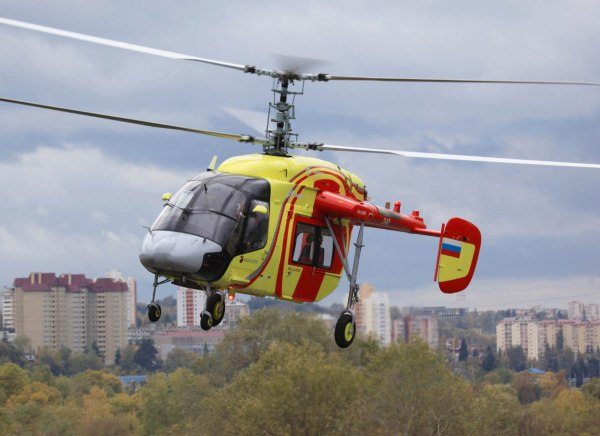New medevac, rescue, and firefighting rotorcraft of Russian make, built by enterprises of the Russian Helicopters holding company, a subsidiary of United Industrial Corporation Oboronprom, may take part in ensuring and enforcing security at the Winter Olympics in Russian seaside resort Sochi in 2014.
Such a conclusion was made after the Russian EMERCOM completed research training in November 2011 in Sochi, in the vicinity of Mamay tunnel and River Mzymta, while preparing for the 2014 Winter Olympics.
The rescuers worked on the prevention and possible ways of overcoming the aftermath of hypothetical natural and man-made emergencies during mass events at various Olympics facilities.
An experimental prototype of the new light multi-role Ka-226T took part in the training. It was developed by Kamov design bureau, a subsidiary of Russian Helicopters. The prototype was employed in flyover monitoring in training areas near River Mzymta and Mamay tunnel for the first time. Thanks to its advanced design and compact coaxial rotors, the helicopter could land on a limited area (about 20 square metres) near a motorway tunnel and evacuated a nominal injured transported on a stretcher. Evacuation was after full touch-down, with engines running.
The absence of a tail rotor on the Ka-226T makes this model extremely apt and safe for evacuation, especially of people on stretchers who cannot get on the helicopter themselves.
The evacuation of the nominal injured went extremely well. The helicopter demonstrated its brilliant capabilities in training and sparked an interest among Russian EMERCOM specialists.
Other rotorcraft of Russian make took part in training apart from the Ka-226T. The new EMERCOM search and rescue helicopter Ka-32A11BC carried out an evacuation of nominal injured in hover mode – under the training legend they had been trapped by a sill flow in the vicinity of River Mzymta.
As of today, helicopters of Russian make, namely the Mi-8/17 and the Ka-32A11BC perform firefighting, medevac, and rescue operations for the Russian EMERCOM, and also take part in erecting key infrastructure for sports facilities in Sochi, as well as performing construction and installation jobs. Medium and heavy models of Russian rotorcraft are used to build major facilities, erect high-voltage power lines, install complex structures atop tall buildings and in mountainous areas.
The Ka-226T is the newest coaxial-rotor helicopter, equipped with two Arrius 2G turboshaft engines built by the French company Turbomeca, as well as the Russian VR-226N reduction-drive gearbox. As of today, this is the first time an Arrius 2G engine was installed on a coaxial helicopter. The solution ensures unprecedented flight safety of the machine: even with one engine it has the necessary maneuver output (750 hp). Modern power trains alongside the special crash-proof fuel system and shock-absorbing chairs make this helicopter one of the most eco-friendly and safe choices in its class.
The outstanding qualities of the Ka-226T rotor system, altitude, and maneuverability were proved during flight tests. One of the most important achievements of the Ka-226T, making it stand out from the competitors, is the practical ceiling of 7300 metres. The outstanding characteristics of the Ka-226T have also been a winning quality in mountainous regions and high-temperature climates, over sea and in highly congested cities, notwithstanding strong winds.
The rotorcraft does not demand hangar storage and is capable of working day and night in adverse weather, under varying winds and in temperatures from -50° to +50°С and 0—100% humidity. Landing gear design is allows landing on unprepared runways and operations from hard top helipads, including oil and gas rigs, as well as loose soil with densities down to 4 kgs/km².
The Ka-226T was developed by Kamov JSC, and is now manufactured by Kumertau Aviation Production Enterprise (a subsidiary of Russian Helicopters). The helicopter has a MTOW of 4 tons with a useful load of 1.45 tons. The maximum speed is 230 km/h, and up to nine people, including two pilots, can be accommodated on board.
Varying cabin modules of the Ka-226T make one helicopter useful for various missions, including cargo and passenger transportation, patrol, construction, loading-unloading, as well as medevac and firefighting, search and rescue and evacuation operations.
Russian Helicopters, JSC is a subsidiary of UIC Oboronprom, which in turn is a part of Russian Technologies State Corporation. It controls the following helicopter industry enterprises: Mil Moscow Helicopter Plant, Kamov, Ulan-Ude Aviation Plant, Kazan Helicopters, Rostvertol, Progress Arsenyev Aviation Company named after N.I. Sazykin, Kumertau Aviation Production Enterprise, Stupino Machine Production Plant, Reductor-PM and Helicopter Service Company.










